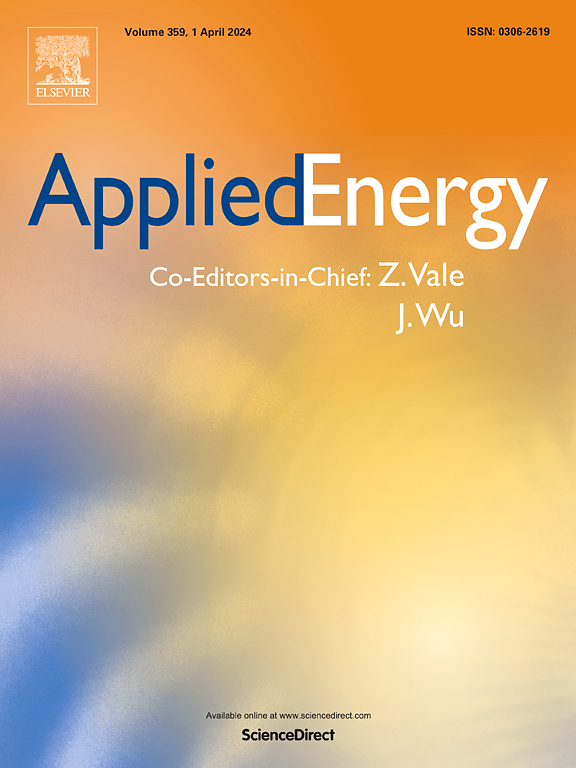A review of the performance and application of molten salt-based phase change materials in sustainable thermal energy storage at medium and high temperatures
IF 11
1区 工程技术
Q1 ENERGY & FUELS
引用次数: 0
Abstract
Growing energy demand and environmental pollution issues are placing greater demands on sustainable thermal energy storage. Research indicates that molten salt phase change materials (MSPCMs) represent a promising alternative for thermal energy storage (TES), effectively addressing the energy supply-demand imbalance. These salts typically have a range of excellent properties, such as high energy storage density, easy availability, and minimal environmental impact. Nevertheless, the widespread application of molten salts is considerably constrained in both industrial and commercial contexts due to their low thermal conductivity (TC) and leakage problems during phase transitions. Based on this, this paper provides a comprehensive examination of the synthesis and energy conversion characteristics of molten salt composite phase change materials (CPCMs), along with the integrated utilization of solid waste materials. Additionally, the potential applications of these phase change materials (PCMs) across various domains are thoroughly explored. The study also addresses the corrosion behavior of encapsulation materials induced by molten salt-based CPCMs. The findings indicate that the development of solid waste-derived and Shape-stabilized CPCMs (SSCPCMs) offers promising solutions to mitigate these challenges. Nevertheless, it is important to acknowledge that conventional energy conversion materials are predominantly organic, and research into molten salt CPCMs remains in its nascent stages, with current applications mainly limited to photothermal and magnetocaloric energy conversion. Furthermore, while coatings technology significantly enhances the corrosion resistance of carbon steel in molten nitrate environments, there remains an urgent need for further investigation into more effective corrosion protection strategies and materials. In conclusion, this review provides valuable insights into the prospective advancement of MSPCMs and underscores the necessity for continued research in this domain to fulfill the requirements of sustainable TES systems.
熔盐基相变材料的性能及其在中高温可持续蓄热中的应用综述
不断增长的能源需求和环境污染问题对可持续热能储存提出了更高的要求。研究表明,熔盐相变材料(MSPCMs)是一种很有前途的热能储存(TES)替代方案,可以有效地解决能源供需不平衡问题。这些盐通常具有一系列优异的性能,如高能量存储密度,易于获得,对环境的影响最小。然而,由于其低导热性(TC)和相变过程中的泄漏问题,熔盐在工业和商业环境中的广泛应用受到很大限制。在此基础上,本文对熔盐复合相变材料(CPCMs)的合成、能量转换特性以及固废材料的综合利用进行了全面研究。此外,还深入探讨了这些相变材料在各个领域的潜在应用。研究还探讨了熔盐基cpcm对封装材料的腐蚀行为。研究结果表明,固体废物来源和形状稳定的cpcm (SSCPCMs)的发展为缓解这些挑战提供了有希望的解决方案。然而,重要的是要认识到,传统的能量转换材料主要是有机的,对熔盐cpcm的研究仍处于起步阶段,目前的应用主要限于光热和磁热能转换。此外,虽然涂层技术显著提高了碳钢在熔融硝酸盐环境中的耐腐蚀性,但仍迫切需要进一步研究更有效的防腐策略和材料。总之,这篇综述为mspcm的未来发展提供了有价值的见解,并强调了在这一领域继续研究以满足可持续TES系统要求的必要性。
本文章由计算机程序翻译,如有差异,请以英文原文为准。
求助全文
约1分钟内获得全文
求助全文
来源期刊

Applied Energy
工程技术-工程:化工
CiteScore
21.20
自引率
10.70%
发文量
1830
审稿时长
41 days
期刊介绍:
Applied Energy serves as a platform for sharing innovations, research, development, and demonstrations in energy conversion, conservation, and sustainable energy systems. The journal covers topics such as optimal energy resource use, environmental pollutant mitigation, and energy process analysis. It welcomes original papers, review articles, technical notes, and letters to the editor. Authors are encouraged to submit manuscripts that bridge the gap between research, development, and implementation. The journal addresses a wide spectrum of topics, including fossil and renewable energy technologies, energy economics, and environmental impacts. Applied Energy also explores modeling and forecasting, conservation strategies, and the social and economic implications of energy policies, including climate change mitigation. It is complemented by the open-access journal Advances in Applied Energy.
 求助内容:
求助内容: 应助结果提醒方式:
应助结果提醒方式:


